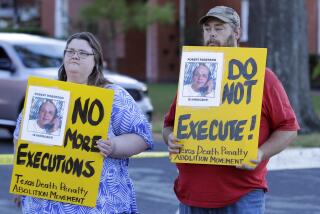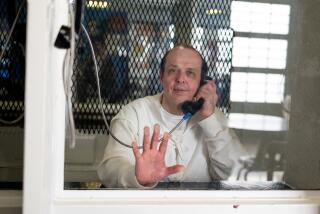State Will Help Shape Fate of Lethal Injection
- Share via
By halting the execution of convicted murderer Michael Morales this week, California finds itself at the forefront of a growing debate about whether being put to death by lethal injection is more humane than other methods or in reality masks a painful end.
The question is likely to intensify in the coming months as the U.S. Supreme Court considers the issue and California reexamines its procedure after a federal judge said the method had to be modified because of concerns he had after reviewing evidence of recent executions.
More than 840 people across the nation have been executed by lethal injection in the last 30 years, but the issue of whether it violates the constitutional prohibition against cruel and unusual punishment has only recently come to the fore.
Death penalty foes such as Century City attorney Stephen Rhode think the debate signals a critical moment in the history of capital punishment.
“They are hitting the wall in the futile search for a humane death penalty,” said Rhode, vice president of Death Penalty Focus, which spearheads opposition to capital punishment in California.
Most legal analysts doubt that the Supreme Court will conclude that lethal injection violates the constitutional ban.
Joshua Marquis, an Astoria, Ore., prosecutor and vice president of the National District Attorneys Assn., likened the court challenges to a “Hail Mary” pass by a football team late in a game. But even advocates of the death penalty think that states may be required to change their procedures.
California “is legitimately criticized for not doing enough homework on the protocol,” which calls for a three-drug cocktail of a sedative, a paralytic agent and a heart-stopping chemical, said Kent Scheidegger, legal director of the Criminal Justice Legal Foundation in Sacramento.
The protocol was first adopted in Oklahoma in 1977, and “states just seem to copy [it] without much scientific backup for what they adopted,” he said.
Scheidegger, whose organization actively defends capital punishment in major court cases, said two events in the last year have given the issue momentum: an article in a medical journal and action by the Supreme Court.
In April, the British journal Lancet published an article saying lethal injection, employed by 37 U.S. states as presumably painless, may inflict unnecessary suffering because of a routine failure to use enough anesthesia, according to a study of autopsies of executed inmates.
That article gave ammunition to defense lawyers seeking to challenge lethal injections.
Then, in recent months, the Supreme Court agreed to stay two executions in Florida until it resolved the question of whether death row inmates can bring last-minute civil rights challenges that execution by lethal injection is cruel and unusual.
Those cases are not a direct challenge to Florida’s execution procedure, but the Supreme Court’s action prompted immediate reaction from Gov. Jeb Bush.
Earlier this month, Bush said he would not sign any more execution warrants until the issue was resolved.
“We don’t know why the Supreme Court’s done what it’s done, so the uncertainty probably does create a need to wait,” he said.
In mid-February, a team of lawyers, led by veteran Supreme Court litigator Thomas C. Goldstein of Washington, D.C., asked the high court to review a Tennessee Supreme Court decision that upheld the constitutionality of the state’s lethal injection protocol, which is similar to California’s.
In particular, the attorneys for condemned inmate Abu-Ali Abdur’Rahman say the use of the drug Pavulon (also known as pancuronium bromide) is unconstitutional because of the risk that it will result in their client’s suffering inhumane pain.
It is not clear whether the Supreme Court will take the case. But Abdur’Rahman’s lawyers, who have mounted a carefully sculpted challenge to the Tennessee law, are hopeful. Unlike many of the other recent legal assaults, “this case is not an eve-of-execution challenge and presents a very well-developed record” from courts in Tennessee, said Amy Howe, Goldstein’s partner.
There are also challenges pending in several other states, including Maryland, Missouri and Texas.
California, which has the nation’s largest death row population -- 647 -- became a focal point of the debate this week when it had to halt the execution of Morales because officials said they could not comply with new requirements imposed by U.S. District Judge Jeremy Fogel of San Jose.
Fogel acted in response to legal motions filed by Morales’ attorneys, who claimed that the state’s execution protocol violated the 8th Amendment ban on cruel and unusual punishment. Fogel made it clear that he was not striking down lethal injections but was trying to make the state adhere to more rigorous procedures and a process that would be easier to scrutinize.
California has executed 11 people by lethal injection, with the first being William Bonin in 1996.
By “tinkering with the machinery of death,” Fogel may have a significant impact on how the state conducts executions and perhaps on the death penalty itself, said UC Berkeley law professor Frank Zimring, author of the 2003 book “The Contradictions of American Capital Punishment.”
What happened in the Morales case, Zimring said, “is a wonderful example of how much the whole execution process depends on worked-out routines that normally don’t get challenged.”
Until recently, he said, California, like most other states, had “insulated the lethal injection process from the need for medical involvement in a way that meant doctors’ reservations about participation would not get in the way of the process.”
But Fogel said the state had to either have an anesthesiologist monitor the execution or use a different drug regimen. Two anesthesiologists initially agreed to participate but then balked, saying it would violate their medical ethics.
Then, on Tuesday evening a spokesman at San Quentin State Prison said the state had not been able “to find any medical professionals willing to inject medication intravenously, ending the life of a human being.”
Consequently, Morales’ execution was stayed, and Fogel will preside over a full evidentiary hearing on the state’s execution procedures in May.
However he rules, appeals -- followed by intense scrutiny of any new method that is adopted -- seem likely.
“First and foremost, what we are seeing is the same problems with previous methods of execution,” said Elisabeth Semel of UC Berkley’s Boalt Hall School of Law.
“When human beings endeavor to kill one another, there is no such thing as a perfect, clean, problem-free process.”
*
(BEGIN TEXT OF INFOBOX)
Death by lethal injection
San Quentin execution chamber
Questions about California’s lethal injection process led to the postponement of Michael Morales’ execution Tuesday and will be addressed in May when a federal judge holds hearings on whether California’s method constitutes cruel and unusual punishment.
Proposed Morales execution (would have taken up to 45 minutes)
1. At least 5 grams of sodium thiopental is administered by a medical professional in the chamber.
2. 20 cc saline flush is performed.
*
Standard procedure (about 20 minutes)
1. Saline solution is administered via IV into inmate’s veins.
2. Sodium thiopental (5 grams in 20-25 cc of diluent), a strong tranquilizer, is administered, then the IV line is flushed with saline solution. This is followed by pancuronium bromide (50 cc), which paralyzes all muscles, and finally potassium chloride (50 cc), which stops the heart. All this is done from outside the chamber.
*
Sources: California Department of Corrections and Rehabilitation, Times reports
More to Read
Sign up for Essential California
The most important California stories and recommendations in your inbox every morning.
You may occasionally receive promotional content from the Los Angeles Times.










